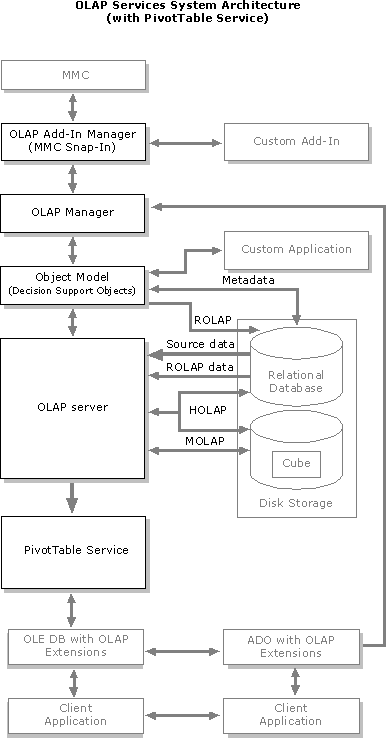
Microsoft® SQL Server™ OLAP Services version 7.0 includes the OLAP server and PivotTable® Service. The OLAP server creates and manages multidimensional data cubes and provides multidimensional data to PivotTable Service, which in turn provides this data to clients through Microsoft ActiveX® Data Objects (Multidimensional) (ADO MD) and OLE DB for OLAP provider services.
The server stores cube metadata (cube definition specifications) in a repository. Completed cubes can be stored in a variety of storage modes: as multidimensional database files (MOLAP), as tables in a relational database (ROLAP), or as a hybrid of multidimensional database files and relational tables (HOLAP).
Source data for multidimensional cubes resides in relational databases where the data has been transformed into a star or snowflake schema typically used in OLAP data warehouse systems. OLAP Services can utilize data from many relational databases that provide connection via ODBC or OLE DB. When used with SQL Server 7.0, OLAP Services offers enhanced security and other capabilities. The Data Transformation Services (DTS) of SQL Server version 7.0 provide a means to manage the data warehouse from which OLAP Services creates cubes.
Control of the server is accomplished through the OLAP Manager user interface, or through custom applications developed using the Decision Support Objects (DSO) object model. DSO controls the creation and management of cubes by the server, and manages the cube metadata in the repository. The object model is used by the OLAP Manager program that provides the user interface through a snap-in to Microsoft Management Console (MMC). The DSO object model can be used by applications written in Microsoft Visual Basic® to provide custom programmatic control of the server. You can also develop custom applications to interact with the OLAP Manager user interface.
The following diagram illustrates the elements and functions of the OLAP server and its use of PivotTable Service to provide multidimensional data to client consumer applications. Note that the OLAP Manager user interface uses PivotTable Service to obtain multidimensional data from the server for browsing by the server administrator. For more information about client applications, see PivotTable Service.
